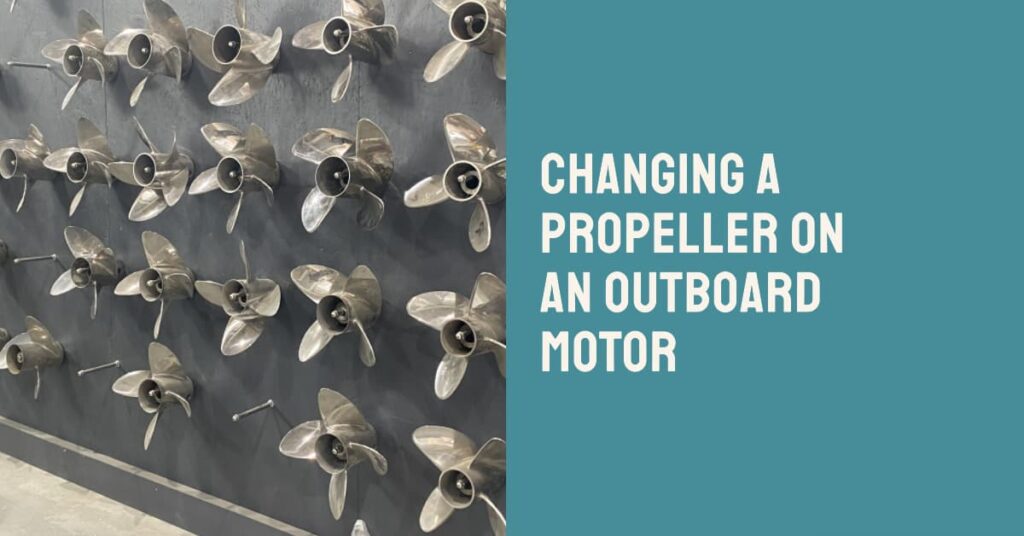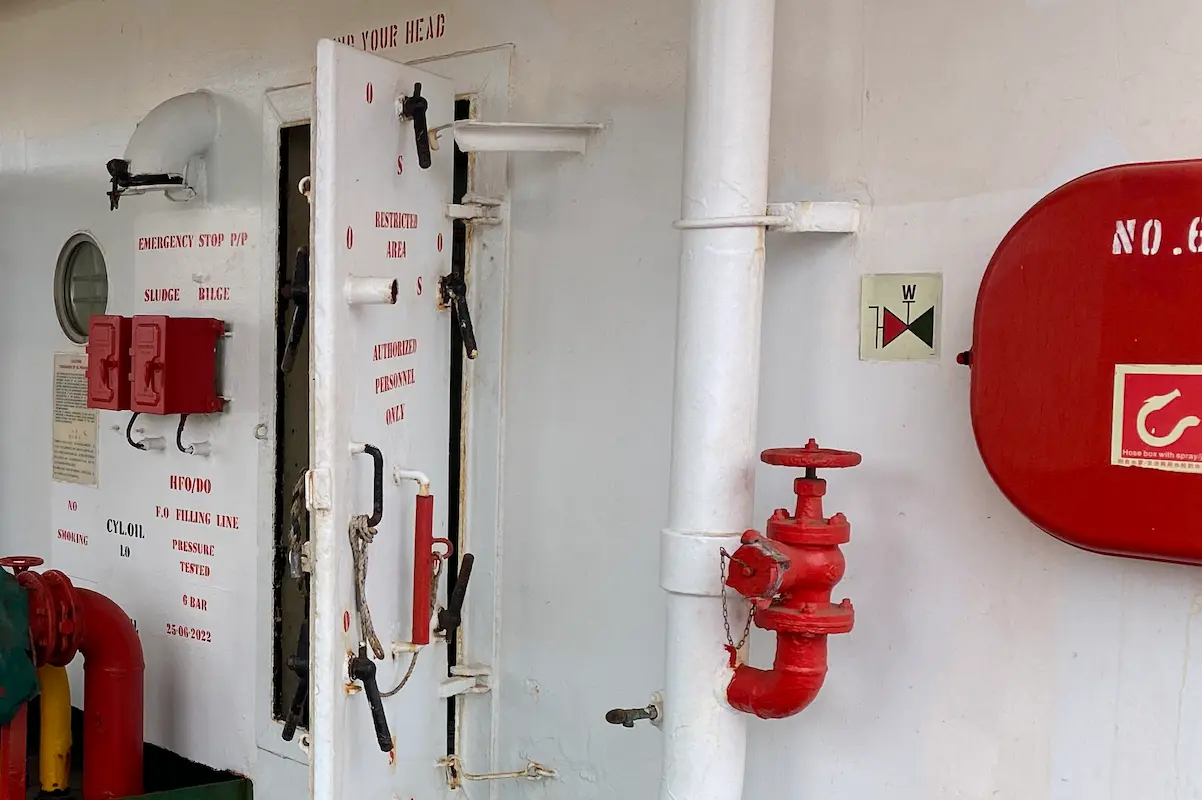For every boat enthusiast, knowing how to change a propeller on an outboard motor is a vital skill. The propeller is an essential component for steering and maintaining the speed of your boat, and over time, it may require replacement due to wear and tear or damage.
Whether you need to swap propellers for improved performance or replace a damaged one, getting familiar with the process is crucial for every boat owner.
Before diving into the task of changing your outboard motor’s propeller, it’s important to gather the necessary tools and gather some basic understanding of the parts involved.
By learning about propeller types, rotation, installation, and maintenance, you’ll be well-equipped to tackle the job with confidence, ensuring the optimal efficiency and performance of your boat.

Key Takeaways
- Familiarize yourself with propeller types and rotation for optimal performance
- Carefully inspect the propeller shaft and surrounding components during the replacement process
- Regular maintenance and troubleshooting can prevent and resolve common propeller issues
Preparing for the Task
Before beginning the process of changing a propeller on an outboard motor, it’s essential to gather the necessary tools and have a clear understanding of the maintenance required. Proper preparation ensures safe and efficient task completion.
To start, assemble a set of essential tools for the job. These tools typically include a propeller wrench, a block of wood, a flathead screwdriver, a pair of pliers or needle-nose pliers, and a new propeller with the correct replacement part. Additionally, you may need a cotter pin, a lock washer, or a castle nut depending on your outboard motor’s specific requirements.
Regular maintenance of the outboard motor propeller is vital for optimal performance and longevity. Inspect the propeller for damage, such as dents, cracks, or excessive wear, and replace it when necessary. Additionally, check the prop shaft for any signs of corrosion or deterioration. It is also crucial to lubricate the prop shaft periodically to ensure smooth operation and reduce friction that can cause wear over time.
When replacing a propeller, it’s important to choose the right size and pitch for your outboard motor. Consult the motor manufacturer’s guidelines or seek advice from a marine professional if you are unsure. Installing an incorrect propeller can lead to poor performance and potential damage to your outboard motor.
By gathering the necessary tools, performing routine maintenance, and choosing the correct replacement propeller, you are well-prepared to change a propeller on an outboard motor confidently and effectively.
Choosing the Right Propeller
When selecting a propeller for your outboard motor, it’s crucial to consider factors such as pitch, performance, fuel economy, and materials. Making the right choice can lead to improved boat handling and acceleration, as well as contributing to the overall efficiency of your motor.
The pitch of a propeller refers to the angle at which its blades are set, which affects the distance the boat will travel with each rotation. A higher-pitch propeller will provide faster top-end speeds but may result in slower acceleration and less responsiveness, while a lower-pitch propeller will deliver quick acceleration and better maneuverability at the cost of a reduced top speed.
It’s important to select a pitch that complements your boat’s intended use, whether that’s cruising, waterskiing, or high-speed performance.
Propeller materials are another important aspect to consider. Aluminum propellers are lightweight and relatively inexpensive, making them a popular choice for general recreational boating. They offer good performance and fuel economy but can be more susceptible to damage if they come into contact with underwater obstacles.
On the other hand, stainless steel propellers are more durable, providing better resistance to dents, dings, and corrosion. They also offer improved performance and efficiency due to their thinner blades and flexibility, which allows them to maintain their shape under more extreme conditions.
Considering the performance and fuel economy of a propeller is vital in making the right choice for your outboard motor. A propeller that is well-matched to your engine and boat can result in more efficient power transfer, leading to better overall performance and fuel economy. To achieve this balance, take into account factors such as boat weight and size, engine horsepower, and the intended use of the boat during the selection process.
In conclusion, choosing the right propeller for your outboard motor involves considering factors such as pitch, material, performance, and fuel economy. By taking the time to evaluate your specific needs and selecting a propeller that best matches your engine and boat, you can optimize your on-water experience and make the most of your motor’s capabilities.
Removing the Old Propeller
Before attempting to remove the boat propeller, ensure that the engine is turned off and the boat is secured. It is crucial to inspect the propeller for any visible damage or debris that may be preventing it from functioning properly. Using needlenose pliers, carefully extract any fishing line or debris tangled around the propeller shaft.
Once the area is clear of debris, locate the cotter pin which secures the propeller in place. With your needlenose pliers, grab the end of the cotter pin and remove it with a gentle twisting motion. Be sure to keep track of the pin, as it will be needed when installing the new propeller.
Next, place a block of wood between one of the propeller blades and the ventilation plate to keep the propeller from turning. This will provide enough stabilization to make it easier to remove the propeller. With a proper-sized socket or a prop wrench, loosen and remove the propeller nut by turning it counterclockwise.
Once the nut is removed, gently pull the outboard propeller off the shaft. It should slide off easily, but if it’s stuck due to rust or other mechanical issues, don’t force it. Instead, apply some penetrating oil to the shaft and propeller and let it sit for a few minutes before attempting to remove the propeller again.
Keep in mind that while removing the propeller, it’s essential to pay close attention to the order of the prop, washers, and other parts. Taking a photo of the assembly can help ensure proper reinstallation later.
Inspecting the Propeller Shaft
Before attempting to change a propeller on an outboard motor, it’s important to inspect the propeller shaft to ensure it’s in good working condition. First, examine the shaft for any visible signs of damage, such as bends, cracks, or corrosion. If any damage is found, it’s crucial to address it before proceeding.
Next, clean the propeller shaft using a clean rag to remove any dirt, grime, or old grease that may be present. This will provide a clearer view of the shaft’s condition and ensure that the new propeller is installed onto a clean surface. Be thorough in your cleaning to prevent any issues with the new propeller’s performance.
Once the shaft is clean, check the area where the propeller attaches to the shaft for any signs of wear or damage. If there are indications of excessive wear, consider having the shaft inspected by a professional technician for further analysis. A worn or damaged propeller shaft can lead to performance problems and potential damage to other components of the outboard motor.
Lastly, it’s essential to ensure that the propeller shaft is well-lubricated. Apply a generous amount of marine grease to the shaft before installing the new propeller. This will help prevent corrosion, reduce friction, and ensure a smooth and efficient operation. Be careful not to apply too much grease, as this could lead to difficulties when removing the propeller in the future.
In summary, inspecting the propeller shaft before changing a propeller is a crucial step in maintaining your outboard motor’s performance. By examining the shaft for damage, cleaning it thoroughly, assessing wear, and applying grease, you can ensure that your new propeller will be installed on a well-maintained and efficient propeller shaft.
Installing the New Propeller
Before installing the new propeller, it is important to prepare the prop shaft by cleaning any debris or fishing line near the shaft. Once the area is clean, lubricate the prop shaft using marine grease. Lubricating the prop shaft helps prevent corrosion and makes future removal of the propeller easier.
Start by positioning the thrust washer onto the prop shaft. The thrust washer acts as a barrier between the propeller and the motor, reducing friction and wear. Next, carefully align the new propeller onto the prop shaft, ensuring the splines on the propeller hub match the splines on the prop shaft.
When the new propeller is in place, slide on the propeller nut, also known as the prop nut. It’s essential to tighten the prop nut onto the shaft using a torque wrench. The use of a torque wrench ensures that the propeller nut is secured at the correct torque, measured in foot-pounds. This prevents the propeller from loosening during operation or becoming too tight and difficult to remove in the future.
It’s important to refer to the manufacturer’s specifications for the correct foot-pounds of torque needed for your specific motor. Over-tightening or under-tightening the propeller nut can cause damage to the propeller or motor components, negatively affecting performance and safety.
With the prop nut properly tightened, secure it using a cotter pin, which prevents the nut from loosening due to vibrations during operation. Make sure to bend the ends of the cotter pin around the nut to hold it in place. After completing these steps, the new propeller installation is finished, and the boat is ready for use.
By following these guidelines, you can confidently and safely install a new propeller on your outboard motor, ensuring optimal performance and longevity.
Understanding Propeller Rotation
Propellers play a crucial role in the operation of boats, particularly outboard motors. Understanding how propeller rotation works is essential for boat owners, as it affects the boat’s performance and steering. In this section, we discuss propeller rotation, and how to identify the rotation of a boat’s propeller.
Propellers are designed for either clockwise (right-hand) or counterclockwise (left-hand) rotation. This rotation is essential for producing the thrust that moves the boat through the water. While looking at a boat propeller from astern (from the rear), a right-hand propeller rotates in a clockwise direction, whereas a left-hand propeller rotates counterclockwise. When purchasing a replacement propeller, it is important to know the correct rotation direction of the current propeller, as an incorrect replacement can result in the boat not functioning properly1.
In single-engine boats, the propeller rotation direction is usually standardized (right-hand) for consistency. In twin-engine boats, using both right-hand (standard) and left-hand (counter) rotation propellers is common. This combination eliminates steering torque and provides better straight-line tracking and helm control at high speeds2.
Now that you have a better understanding of propeller rotation, it is crucial to identify the rotation direction of your propeller. For right-hand propellers, the trailing edge (edge farthest from the boat) of the blades will appear higher on the left side when viewed from behind. The exact opposite is true for left-hand (counterclockwise) propellers3.
With this knowledge, you can confidently identify and choose the correct propeller rotation for your boat’s outboard motor, ensuring optimal performance and steering control.
Footnotes
Preventing and Troubleshooting Issues
When it comes to maintaining outboard motor performance, preventing and troubleshooting propeller-related issues is essential. One such issue is cavitation, where air bubbles form in the water around the prop and can cause damage over time. Cavitation can negatively affect acceleration in addition to causing unwanted noise, so it’s crucial to identify and fix the problem.
To prevent cavitation, it’s important to ensure the propeller is in good condition and properly matched to the boat. If your boat is experiencing cavitation, inspect the prop for damage such as bends, cracks, or missing blade sections. Sometimes, replacing the propeller with one that has a different pitch or diameter can resolve the issue. Also, make sure the motor’s mounting height is correct; if it’s too high, the prop might not get enough water to work effectively.
Aside from cavitation, other issues such as bearing and driveshaft problems can cause poor performance and even damage to the motor. Boating in rivers with shallow water or debris might increase the likelihood of encountering these issues.
Regularly inspect the motor’s bearings for wear and tear, and replace them when necessary. Having a properly lubricated and aligned driveshaft is another important factor in maintaining performance and preventing problems. Keep an eye on the motor’s performance, such as vibrations, or strange noises, as these could indicate possible bearing or driveshaft issues.
Ensuring good maintenance plays a key role in preventing propeller-related issues. Follow these tips to help maintain your outboard motor’s performance and prevent or troubleshoot common problems encountered while boating:
- Keep the lower unit and propeller clean: Fouling on the propellers or other underwater components can lead to decreased performance and increased risk of cavitation.
- Regularly inspect for potential damage: After each outing, check the prop for signs of damage and look for any issues that may have arisen with the driveshaft or bearings.
- Choose the right propeller: If changing your boating habits or water conditions, it’s essential to select a suitable propeller for optimum performance and efficiency.
By staying vigilant and performing regular maintenance on your outboard motor, you can enjoy smooth, efficient, and worry-free boating for years to come.
Maintaining Your Boat Propeller
Proper maintenance of your boat’s propeller is essential to ensure its longevity and optimum performance. Regular care and inspections are crucial, as even minor issues can significantly impact your boat’s efficiency and durability. In this section, we’ll discuss the steps involved in maintaining your boat propeller.
First and foremost, it is important to clean your propeller after each use. Wash it with water and a mild detergent solution to remove any salt, oil, or grease that may have accumulated during its operation. This simple step can prevent corrosion and other long-term damage.
Additionally, wiping the blades with a water-repelling lubricant, such as CRC 6-56, can offer further protection against corrosion. This action not only safeguards the propeller but also helps maintain the boat’s overall performance.
Periodically inspecting the propeller for signs of wear or damage is also crucial. Look for bent or cracked blades, as these issues can hinder your boat’s performance and may even pose a safety risk. If you notice any issues, consider seeking professional assistance to assess the problem and determine if the propeller requires repair or replacement.
Aside from visual inspections, pay attention to any unusual vibrations or noises while operating your boat. These signs could indicate a variety of issues, including a damaged propeller or misaligned motor. Addressing such problems promptly not only safeguards your boat’s performance but also prolongs its lifespan.
In summary, maintaining your boat propeller includes regular cleaning, lubrication, and inspections for damage or wear. By incorporating these practices into your routine, you can ensure better performance and durability for your boat, as discussed in this blog.
Conclusion
In this article, we hope to have provided a clear and concise guide on changing a propeller on an outboard motor. With the right tools and instructions, this process can be completed with confidence and ease. If you need further assistance or clarification, it may be helpful to watch a video tutorial on the subject.
For those who prefer a more interactive approach, there are apps available that offer step-by-step guidance for boat maintenance tasks, including propeller replacement. Just be sure to review each app’s privacy policy before downloading, as different apps may have varying policies on user data and personal information.
Ultimately, the key to success in changing a propeller lies in following each step carefully and ensuring the safety measures are in place. With practice and patience, you’ll not only become more familiar with your outboard motor and its components but also gain the knowledge and skills to tackle other boat maintenance tasks and keep your time on the water enjoyable and worry-free.
Frequently Asked Questions
How can I safely remove a propeller from an outboard motor?
To safely remove a propeller from an outboard motor, follow these steps: First, bend back the tabs on the lock-washer securing the propeller nut or remove the cotter pin from the castle nut. Next, place a block of wood between the propeller’s blades and the ventilation plate to keep the prop from turning. Finally, remove the propeller nut or castle nut, and pull the propeller off the prop shaft 1.
What tools are required to change the propeller on an outboard motor?
The essential tools needed for changing a propeller on an outboard motor include needle-nose pliers, a propeller wrench, and a block of wood. The pliers are used to remove the cotter pin or bend the lock-washer tabs, while the propeller wrench helps in loosening the propeller nut or castle nut. The block of wood is used to prevent the propeller from turning while removing the nut 2.
Which type of propeller wrench should I use for my outboard motor?
The type of propeller wrench you should use depends on the specific model of your outboard motor. Most outboard motors use a universal propeller wrench. However, some may require a unique wrench designed for that specific motor. Consult your motor’s owner’s manual or contact the manufacturer for more information on the appropriate propeller wrench for your outboard motor.
How can I determine the correct propeller hub kit for my outboard motor?
To determine the correct propeller hub kit for your outboard motor, consult your motor’s owner’s manual or contact the manufacturer for more information. You can also check with a knowledgeable marine parts dealer, who can help you identify the right hub kit based on your motor’s make, model, and horsepower rating.
Are there any specific steps to follow when installing a new propeller?
When installing a new propeller, follow these general steps 3: First, clean any debris or fishing line near the shaft and apply a little grease around the base of the shaft. Then, place the new propeller onto the prop shaft, followed by the drive sleeve adapter or splined insert, if applicable. Next, reinstall the propeller nut or castle nut, and tighten it securely using a propeller wrench. Finally, insert a new cotter pin or bend the tabs on the lock-washer to secure the propeller nut.
How can I identify signs of a bad or damaged propeller?
Signs of a bad or damaged propeller include vibration, unusual noise, reduced speed or acceleration, and poor fuel efficiency. These symptoms can indicate issues such as bent or damaged blades, an improper pitch or diameter, or a damaged hub. Inspect your propeller for visible damages or wear, and consult a marine professional if you suspect any issues with your propeller’s performance.
Footnotes
- 11 Boat Salvage Yards in Texas – January 18, 2025
- 7 Boat Salvage Yards in Michigan – January 15, 2025
- Fire Hose SOLAS Requirements, Regulation 10: Ensuring Maritime Safety – January 9, 2025




